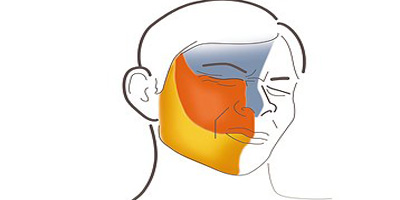Trigeminal neuralgia is a facial pain condition associated with the trigeminal nerve or one of its branches. The primary function of trigeminal nerve is to provide sensory innervation to the face. This nerve is divided into three main branches. Based on the reports of the patients we examined in our pain clinic, we believe that trigeminal neuralgia pain may be the worst pain to experience.
Patients with trigeminal neuralgia typically experience episodes of severe pain on one side of the face. Often described as sharp shooting pain, triggered by simple activities such as chewing, brushing teeth, or putting on makeup. The attack passes within seconds, sometimes it can last for minutes. Pain is usually felt in the cheek area up to the edge of the upper lip, the forehead, eyebrows, and the chin area starting from the lower lip.
Rarely, it can be seen on both sides of the face. These patients usually apply to dentists with these pains; even before the diagnosis is made, many patients have their teeth on the pain side extracted.

It can sometimes be very difficult to fully understand the causes of trigeminal neuralgia. Neuralgia may develop due to damage to the nerve itself, pressure on the nerve, or changes in the nerve’s function. Another point to keep in mind is that in some cases the cause of trigeminal neuralgia may not be found.
Trigeminal neuralgia affects more women than men. It usually starts between the ages of 50 and 60. It is rare in patients younger than 40 years of age.
According to the patient’s characteristic history and neurological examination, the diagnosis of “Trigeminal Neuralgia” is made. Laboratory, electrophysiological tests and radiological imaging are performed to investigate the cause of the disease.
Treatment of trigeminal neuralgia differs from patient to patient, depending on the underlying cause and severity of their pain. Treatment options may include medications, minimally invasive interventional treatments, open brain surgery, or radiation therapy.
Many people who suffer from trigeminal neuralgia have their condition successfully controlled with medications for many years. Medications are usually started at low doses and gradually increased according to the patient’s response to the medication.
Minimally invasive interventional therapies can be used in the treatment of trigeminal neuralgia if drug therapy does not provide sufficient benefit to the patient or if the side effects are intolerable. Commonly used minimally invasive treatments in the management of trigeminal neuralgia:

These procedures should be performed by trained and experienced doctors. Minimally invasive interventional treatments may give the best results when applied early in the course of trigeminal neuralgia. Even if drug therapy comes first, when drug therapy is deemed ineffective, the next step in therapy should be followed. This is an important consideration so as not to delay or reduce the effectiveness of invasive treatments.
Microvascular decompression surgery, which is an open surgical method, is generally recommended for younger patients. It is especially performed in patients with isolated pain in the ophthalmic main branch of the trigeminal nerve or all 3 main branches of the trigeminal nerve and patients with secondary trigeminal neuralgia. It is currently the most common surgical procedure performed for patients with trigeminal neuralgia. Surgery appears to be less effective for trigeminal neuralgia secondary to multiple sclerosis (MS).
Treatment using radiation therapy(Gamma Knife Therapy) appears to be as effective (80% of patients) as minimally invasive interventional therapy, but it takes weeks to months to bring relief, which is too long for some patients and is more expensive